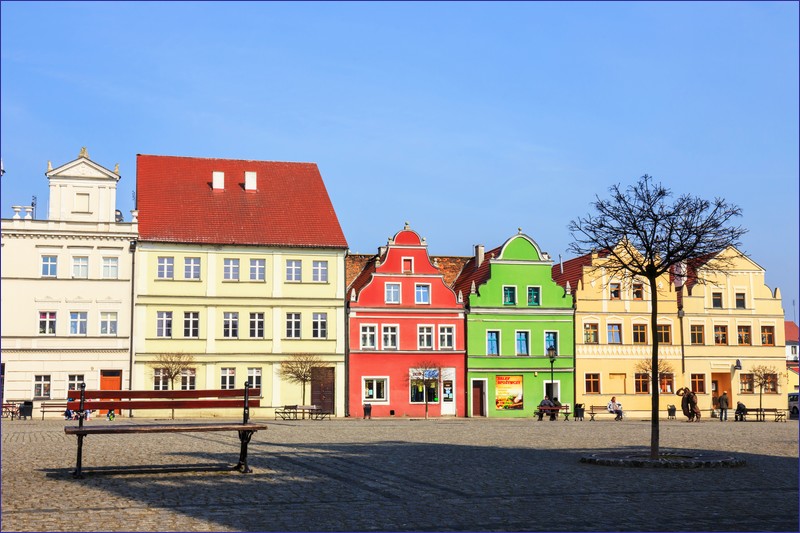Wrocław is the capital of the Lower Silesian Voivodeship and one of the largest cities in Poland. A popular destination for tourists from all over Europe, it is also an important railway hub. From Wrocław, you can quickly reach many interesting places across Poland.
In the article, I briefly described the places that can be reached from Wroclaw by regional trains in less or about two hours. If you will choose fast trains, you can quickly get to Krakow and Zielna Gora. However, these trains are significantly more expensive than regional trains. Regional trains in Wroclaw area are mainly served by Koleje Dolnośląskie.
Day trips from Wroclaw by train – direction Kłodzko
A very popular train route among tourists with many interesting attractions along the way. On weekends trains are often overcrowded.
Henryków – it’s worth getting off at the local station to see the Cistercian monastery complex with a park and a richly decorated church. Part of the complex serves social functions (nursing home, school). As far as I know, the interiors can only be visited with a guide, but the park and the monastery surroundings are accessible without prior reservation.
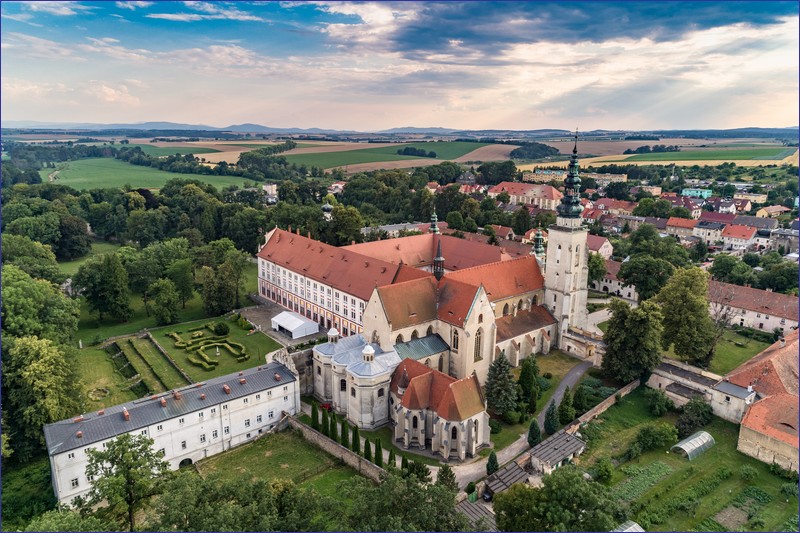
Ziębice – a typical Lower Silesian town with a pleasant market square and a few monuments, such as the Minor Basilica of St. George. The small center leaves a positive impression. It’s worth visiting the Museum of the Silesian House – a combination of a regional museum and a specialist museum located in the former town hall.
Bardo – a small, picturesque town located in a bend of the Nysa Kłodzka River, known for its mountain trails and the Sanctuary of Our Lady of Bardo, part of which is the Museum of Sacred Art. Inside, there is a precious, miraculous figurine of Our Lady of Bardo from the 12th century. The stone bridge is also worth seeing.
Kamieniec Ząbkowicki – an important railway hub. The Palace of Marianna of Orange is a must-see. From Kamieniec Ząbkowicki, it’s worth taking a bus to Złoty Stok, 12 kilometers away, where tourists can visit the Gold Mine, a replica of a medieval mining village, and Skalisko Adventure Park – a rope park with several trails adapted to different levels of difficulty.
Kłodzko – one of the most beautiful cities in Lower Silesia, at least in terms of its center. Tourist guide photos often feature the 14th-century Gothic bridge over Młynówka, sometimes called a miniature version of Prague’s Charles Bridge. In Kłodzko, it’s worth visiting the Church of the Assumption of the Blessed Virgin Mary. The underground route ends at the gate to the Kłodzko Fortress towering over the city – only part of the bastion is open to the public. Finally, you can visit the Museum of Kłodzko Land to learn about the region’s history. The Kłodzko Główne train station is 2 kilometers from the city center, while the Kłodzko Miasto station is much closer to the main attractions.
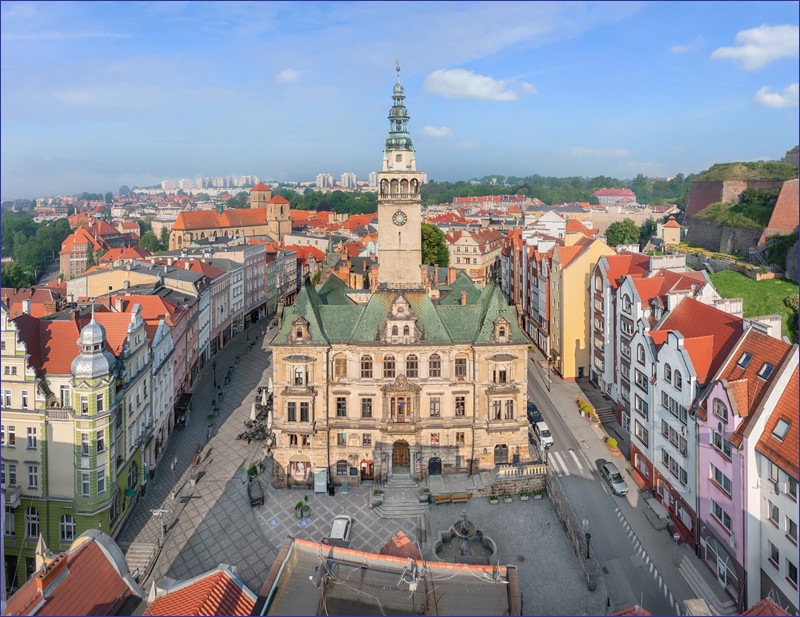
If continuing the journey from Kłodzko towards Międzylesie, you should include Bystrzyca Kłodzka in your travel plan. The town’s panorama is beautifully captured in drone photos; however, reviews from those who have visited suggest the charming, though neglected, center. The town’s main attraction is the Match Museum, located in a former Evangelical church.
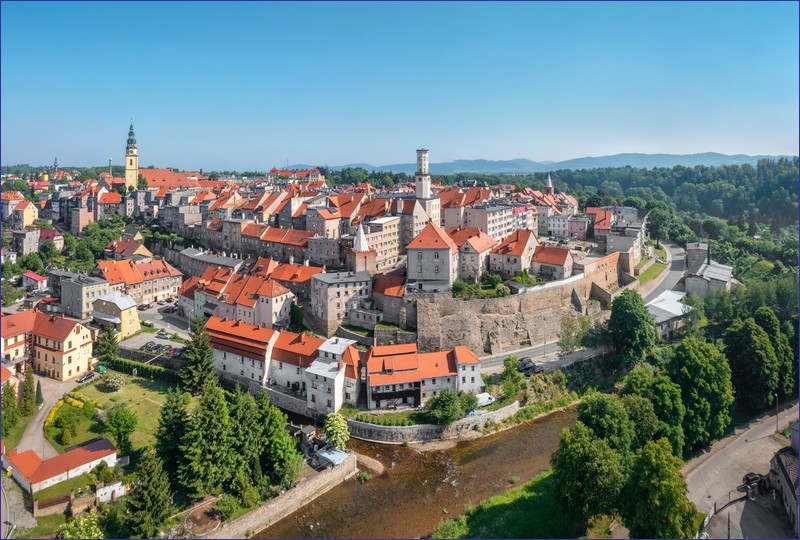
Day trips from Wroclaw by train – direction Jelenia Gora
The most popular railway line in Lower Silesia runs from Wrocław to Jelenia Góra and onward to Szklarska Poręba. I will conclude my suggestions for day trips from Wrocław in the area around Jelenia Góra, as I consider Szklarska Poręba more suitable for a weekend trip for mountain hiking enthusiasts.
Jaworzyna Śląska – a small town famous for Railway Museum of Silesia, showcasing numerous interesting exhibits like the TKt48-18 steam locomotive, the Czechoslovak motor coach series 830, and Poland’s oldest operational diesel locomotive, DEUTZ OMZ 122R from 1940. The museum also features over-100-year-old steam locomotives, TKh2 and TKi3. The steam engine depot infrastructure is preserved, and short train rides on the museum’s tracks are organized during the summer. The museum also hosts the annual Steam Engine Gala.
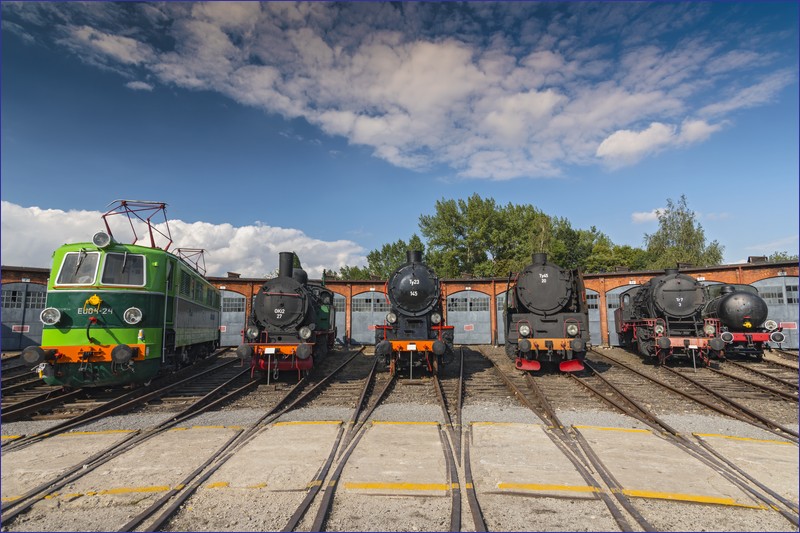
Wałbrzych – a former mining town, unfairly considered one of Poland’s ugliest cities, along with Bytom in Upper Silesia. Wałbrzych’s major attractions are scattered over a large area, and a one-day visit could focus on the slightly neglected city center with many architecturally interesting buildings and alleys, or you could visit the Porcelain Museum housed in a neoclassical palace (a former regional museum, now a combined porcelain and regional museum), followed by the Palm House or Książ Castle. The Stara Kopalnia complex, located on the revitalized site of the former KWK “Julia” mine, with the Museum of Industry and Technology and a hotel, is also very popular. You could also visit Szczawno-Zdrój, a spa town now part of Wałbrzych, accessible by city bus. Thorough sightseeing of Wałbrzych would take several days, but the city has a strange atmosphere and lacks good accommodation options.
Jelenia Góra – a medium-sized city with a lovely center and photogenic market square. The city offers historic churches, walking trails (including one along the Bóbr River), lookout towers (e.g., the Krzywousty Tower), and museums. The most famous are the Karkonosze Museum and, outside the center, the Museum of History and Military, featuring an outdoor Polish Army equipment display. A relatively new attraction is the Museum of Automobiles on the top floor of a shopping mall. Several years ago, the 1.2-kilometer-long underground tourist route “Time Gates” (Bramy Czasu) was opened, featuring both a science section (Tesla coil and scientific experiments) and a history section (stories of Lower Silesia’s history). Guided tours are available, and it’s an attraction for children aged 4-5 and older.
Cieplice Śląskie (optional) – In the summer, it’s worth visiting Cieplice Śląskie-Zdrój, a small spa town with thermal waters and lovely Zdrojowy and Norwegian parks. The train ride from Jelenia Góra takes just 10 minutes.
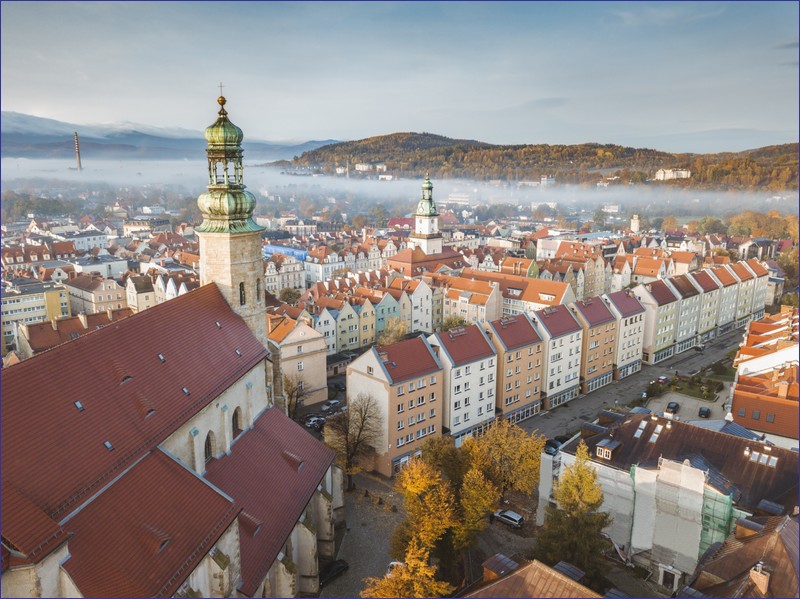
Direction Leszno and Poznań
Rawicz and Leszno are perfect destinations for day trip from Wroclaw by train. The railway line have been recently renovated, so if you take a fast train, you can plan day trip to Poznan.
Rawicz – a town with a beautiful train station located about 15 minutes from the market square. The town’s urban layout is unique – a rectangular market square with streets intersecting at right angles, giving the center a chessboard-like appearance. The Rawicz Regional Museum is housed in the town hall in the middle of the square. Two notable churches stand out – the neo-Gothic Church of Christ the King and the Annunciation of the Blessed Virgin Mary, built between 1902-1903, featuring a 50-meter-high spire, and the former Evangelical Church of St. Andrew Bobola, known for its unusual interior design.
Five kilometers from Rawicz lies Sarnowa, once a separate town, incorporated into Rawicz in 1973. Sarnowa has its own market square and a town hall dating back to 1837.
Leszno and Rydzyna – a former capital of the Leszno voivodeship, Leszno has over 60,000 residents. Most attractions are located in the city center, within walking distance of the train station. The most notable building is the grand town hall, built between 1637-1639 and considered one of the most beautiful in Poland. It was destroyed in 1656, rebuilt, and renovated many times, most recently in 2020. The town hall now serves ceremonial functions.
While the city center is quite charming, it feels like its full potential hasn’t been realized. The small District Museum is located in a townhouse at 17 Jan Metziga Square. Nearby stands the Holy Cross Church, with a lapidarium containing gravestones from old Evangelical cemeteries in the area. Outside the city center, you can visit the Speedway Stars Avenue or explore the mural trail.
The surrounding region is dotted with many wooden or half-timbered churches and windmills, and a trail called “The Hidden Beauty in Wood” has been created for tourists to explore these structures. However, not all are open daily.

A notable site near Leszno is Rydzyna, accessible by train (the station is 3 km from the main attractions) or a suburban bus from Leszno. The town has preserved its baroque urban layout from 1738-1762 and features a windmill (formerly a museum of milling and agriculture), as well as two churches – St. Stanislaus Church and a red-brick former Evangelical church, now a concert hall. The main attraction in Rydzyna is the Rydzyna Castle, a former magnate residence. Part of the castle is open for tours, while the rest functions as a hotel.
From Leszno, you can also take a train to Wschowa (if runs; trains are often cancelled), a town in the Lubusz Voivodeship with a castle-turned-hotel, several sacred buildings, and remnants of defensive walls. In Wschowa, the former Evangelical cemetery houses the Lapidarium of Tombstone Sculptures, dating back to 1609, and the Museum of the Wschowa Land is also worth a visit.
Poznań – one of the largest cities in Poland and the capital of the Greater Poland Voivodeship, offering many interesting attractions. Poznań Główny train station is located close to the city center and its main sights. A one-day sightseeing itinerary includes walking from the main station to the market square (one way via the bus station, the other via Św. Marcin Street, with a stop at Stary Browar for a stroll), visiting the collegiate basilica near the market with its beautiful interiors, then heading to Ostrów Tumski (with the cathedral and the famous 3D mural in Śródka). Optionally, you can take a walk along Lake Malta, and in season, ride the narrow-gauge Maltanka train operated by MPK Poznań.
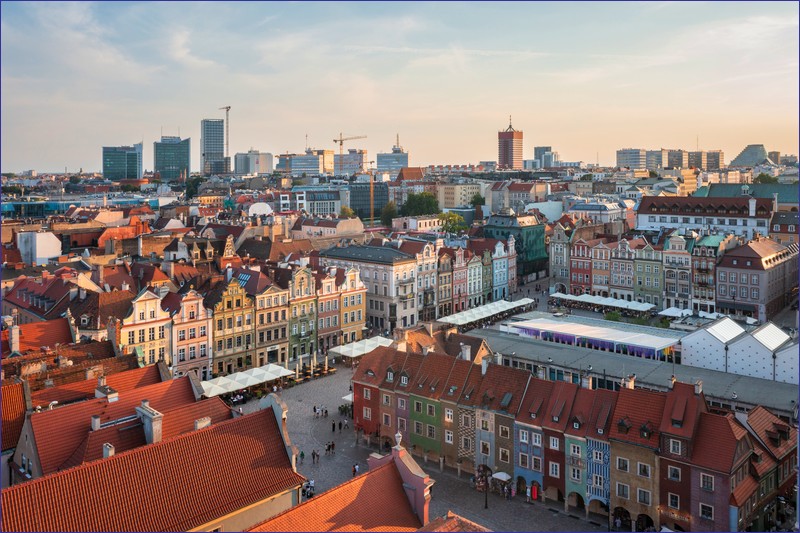
Day trip from Wroclaw to Opole via Brzeg and Oława
When planning a one-day train trip from Wrocław, you can also consider traveling to Brzeg and Opole, along the route of the first railway line on what is now Polish territory (the first train reached Oława). I will describe Opole briefly since the city has several other attractions that make it a good option for a weekend trip as well.
Brzeg – A city known for the Piast’s castle, which somewhat resembles Wawel Castle in Krakow, though on a signifantly smaller scale. It takes about 15 minutes to walk from the historic train station to the castle, passing through the city center along the way. You will come across various historic buildings here and there. Opposite the castle stands the impressive Church of the Exaltation of the Holy Cross, and right behind it is the Church of St. Jadwiga – the mausoleum of the Silesian Piast dynasty. In this church, 43 rulers of the dynasty were buried, with 22 sarcophagi preserved. Nearby, you’ll find one of the most beautiful Renaissance town halls in Poland, whose facade was recently restored.
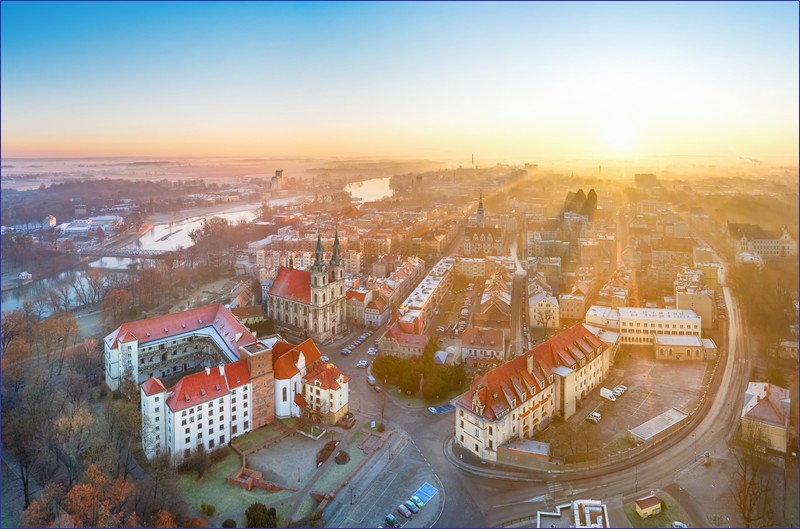
Opole – The capital of the Opole Voivodeship. The charming city center is located close to the historic train station. A one-day trip to Opole should include a walk along the Młynówka canal, a visit to the Piast Tower, a remnant of the former castle, a tour of the Museum of Opole Silesia, and for song enthusiasts, the Museum of Polish Song. The city features both sacred monuments and modern buildings. I think that one day is enough for Opole.
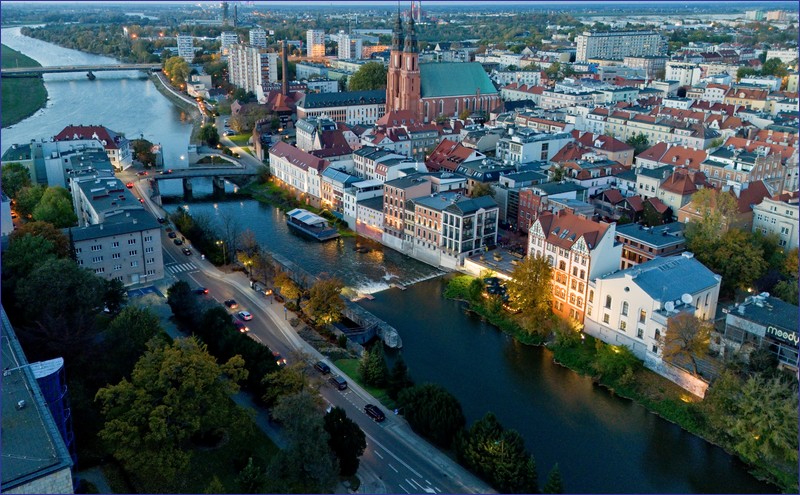
Train Wroclaw – Namyslow – Kluczbork
Train passengers traveling from Wrocław towards Kluczbork should make a stop in Oleśnica and Namysłów. Due to the condition of the tracks, the journey can be quite tiresome; hopefully, the line will be renovated in the future.
Oleśnica (optional) – an average city, but worth stopping at to visit the Castle of the Dukes of Oleśnica, which for a long time was not open to the public. On the courtyard, the coats of arms with busts catch the eye, and inside, visitors can explore the Knight’s Hall, Wilhelm’s former office, and the tower offering a panoramic view of the city. Other city attractions include the Dukes of Oleśnica Park, and also worth noting is the Minor Basilica of St. John the Evangelist Apostle.
Namysłów (optional) – an interesting town in the Opole Voivodeship, relatively rarely visited by tourists. In the intimate town center, located not far from the train station, you can see the Gothic Church of St. Peter and Paul from the mid-15th century, preserved defensive walls with the Kraków Gate, and the town hall from the second half of the 14th century with its characteristic 57-meter tower.
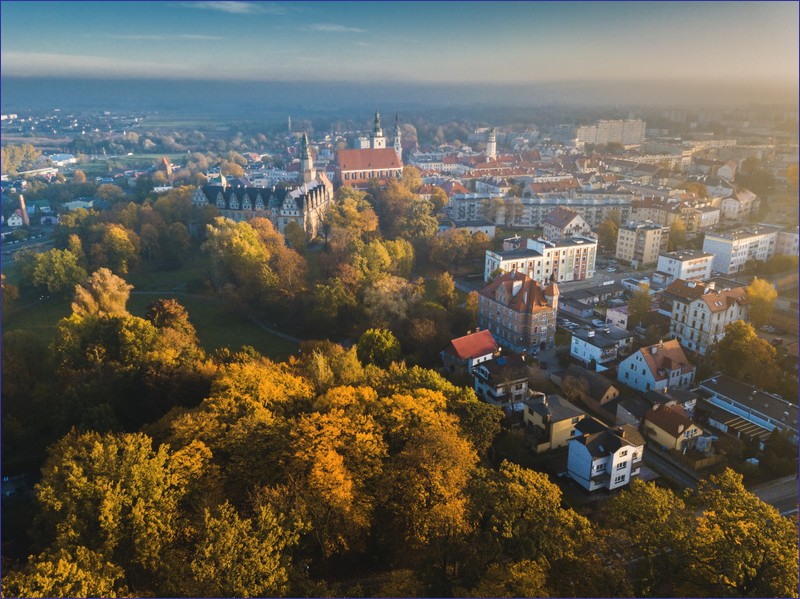
Direction Zgorzelec
Traveling by train towards Zgorzelec, it’s worth stopping in a few towns along the way, with additional trip to Jawor.
Środa Śląska (optional) – a town located far from the train station. Its biggest attraction is the famous “Środa Treasure” – items and valuables discovered during the demolition of a building in the city center in 1985 and 1988. The treasure is displayed in the Regional Museum, but keep in mind that it is moved to a rotating exhibition at the National Museum in Wrocław in autumn, so you won’t be able to see it in Środa Śląska at the end of the year. The town also has preserved defensive walls over 1.5 km long, and the narrow market square, over 300 meters long, with the town hall at its center, is noteworthy. Other landmarks include the churches of St. Andrew the Apostle, the Nativity of the Virgin Mary, and the Elevation of the Holy Cross.
Legnica (optional) – a medium-sized city and railway hub, not very popular among tourists, although it does have some interesting spots. Many historical buildings were destroyed by the Red Army in 1945, so isolated historic landmarks now stand alongside communist-era structures. Highlights include the Cathedral of St. Peter and Paul, the Church of the Virgin Mary, the town hall, and the “Śledzionki” townhouses. Also worth visiting are the Copper Museum, the courtyard of the Piast Castle, and Tarninów district (the most beautiful part of the city with preserved historic buildings). Near Legnica is the Museum of the Battle of Legnica with adjacent beautiful baroque church.
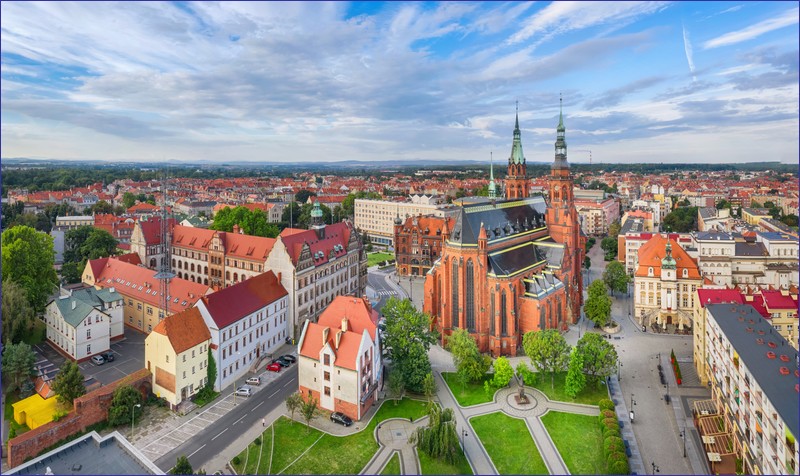
Jawor (optional) – you can take a train from Legnica to nearby Jawor, where one of two preserved Peace Churches in Poland is located. The beautifully decorated Jawor church can accommodate up to 6,000 people. The city’s other major attraction is the Regional Museum. The local castle now houses several businesses and institutions, and the part open for visiting has received poor reviews. The recently renovated historic train station is also noteworthy.
Bolesławiec – a fascinating place famous for its ceramic production. The recently renovated train station is very close to the city center, where you can visit the market square, two buildings of the Ceramic Museum (one housing the Ceramic Department, the other the City History Department), and fragments of the city walls. Among religious landmarks, the Church of the Assumption of the Virgin Mary and St. Stanislaus (1482–1521) is worth visiting. Outside the city center, the Living Ceramic Museum offers a glimpse into the production process and painting of ceramics. Visitors can also participate in ceramic decoration workshops.
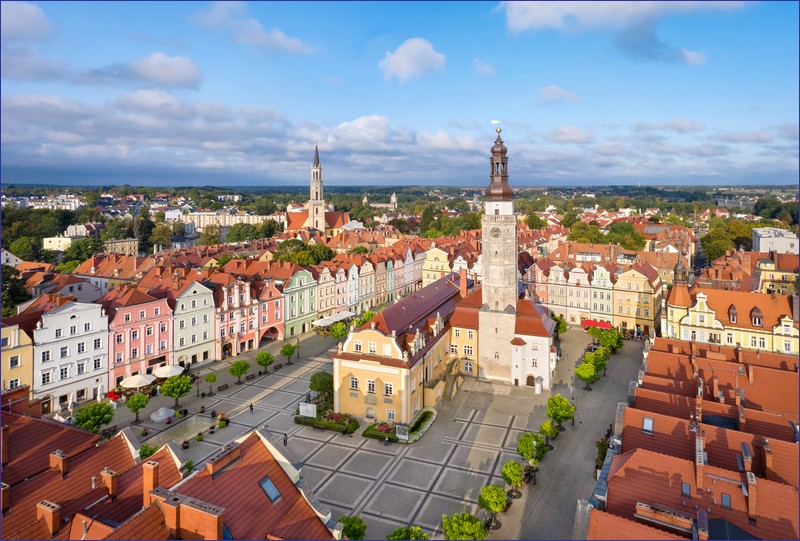
Direction Świdnica and Ząbkowice Śląskie
The best way to reach Świdnica is by taking a train from Wrocław via Sobótka, along the recently revitalized and reopened line. From Świdnica Miasto station, you can continue your journey on trains heading towards Dzierżoniów and even to Bielawa.
Sobótka (optional) – At the Sobótka station, many tourists disembark to hike up Mount Ślęża. Along the way, you’ll pass the Bismarck Tower, and at the mountain’s peak, there’s the Church of the Nativity of the Virgin Mary, built on the site of a former medieval fortress. In the town, it’s worth visiting the market square, featuring models of the Ślęża Massif and 18th-century Sobótka, as well as the Ślęża Museum. There are many natural attractions in the surrounding area.
Świdnica – The town center and main attractions are within walking distance from the Świdnica Miasto train station. Key landmarks include the famous and beautiful Church of Peace with its small cemetery, the majestic cathedral, the picturesque market square with its Town Hall Tower (offering panoramic views of Świdnica and the surrounding mountains), and the Town Hall building, which now houses the highly recommended Museum of Old Commerce. Throughout the center, you’ll find historic villas and townhouses, and in good weather, a stroll through Świdnica’s parks is well worth it. The town also has a well-developed culinary scene.
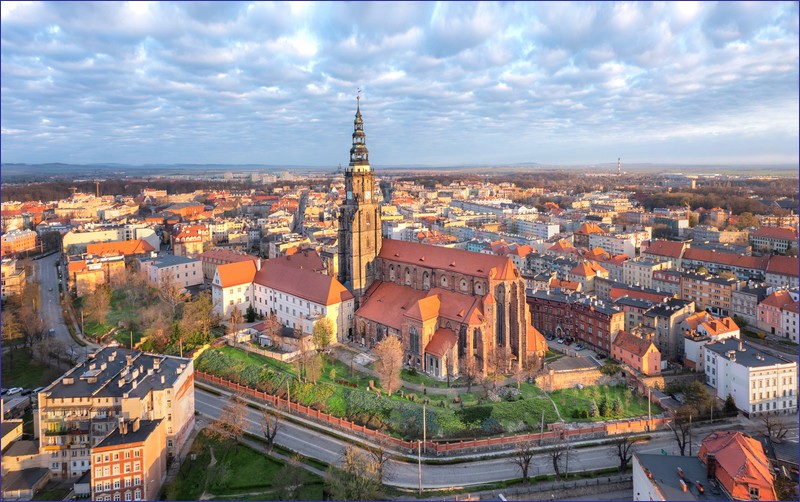
Dzierżoniów – Another lesser-known town in Lower Silesia among tourists. It serves as an excellent base for bus, hiking, and train excursions in the surrounding area, though accommodations are quite expensive. The market square is typical of Lower Silesian towns, distinguished by its 47-meter-high Town Hall Tower, which is open to tourists and offers panoramic views of the Owl Mountains and Mount Ślęża. The town is home to several interesting sacred monuments and remnants of city walls. Highlights include the Dzierżoniów City Museum, housed in a palace from 1897, with a collection of vintage Diora radios once made here, and Hilbert’s Mill, open on weekends, showcasing production lines preserved from the 1930s.
You can continue your journey to Ząbkowice Śląskie.
Ząbkowice Śląskie – An interesting town known for its Leaning Tower, the city’s most famous attraction. Other notable sites include the Regional Room, the Church of St. Anne, and the market square with its town hall featuring a distinctive tall tower. Fragments of the medieval city walls have also been preserved. The castle ruins are more appealing to a niche group of tourists.
Direction Zielona Góra
Less-known and less frequently visited places can be found along the railway line from Wrocław to Szczecin via Zielona Góra. The popular Nadodrzanka line provides train access from Wrocław to several interesting towns, of which I’ll mention only those closest to the Lower Silesian capital. There are three ideas for the perfect day trip from Wroclaw by train.
Wołów (optional) – During the fighting in 1945, 70 percent of the town’s buildings were destroyed. After the war, the area was resettled by people from the eastern Polish territories. Wołów’s cozy town center is home to mostly religious monuments, including the Church of St. Lawrence (14th century) with baroque organs by Adam Horatio Casparini and the Church of St. Borromeo. The castle has lost much of its character and now serves as the seat of the County Office, but during office hours, you can climb its 15-meter tower. Fragments of the defensive walls remain, and next to them is a statue titled “Wołowskie woły” (Wołów’s oxen), referencing the town’s history.
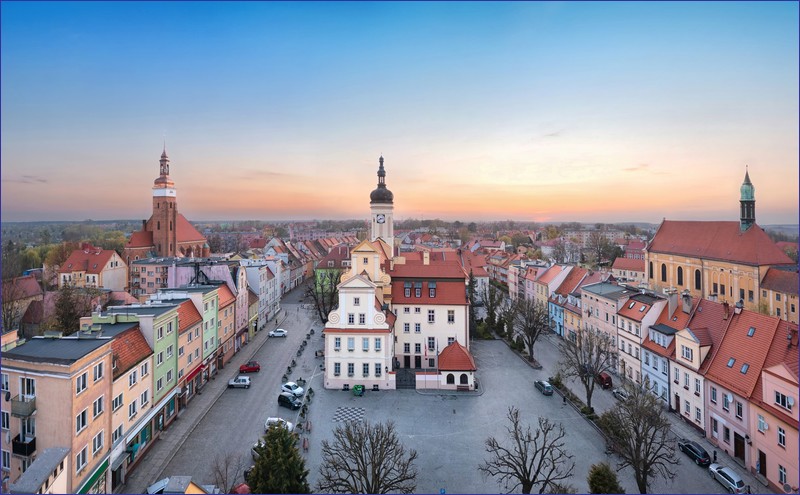
From Wołów, there is a bike path along the old railway tracks leading to Lubiąż, where you must visit the Cistercian Monastery complex.
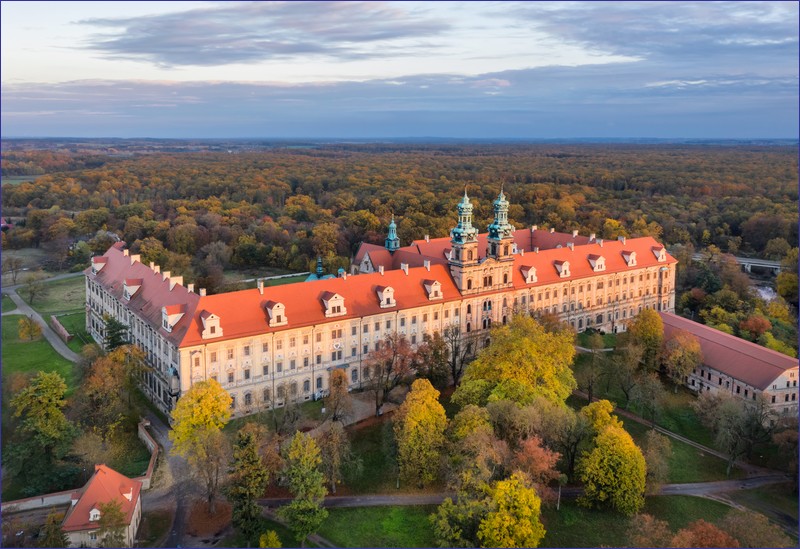
Bytom Odrzański – A small town with a beautiful market square surrounded by ornate bourgeois townhouses. It’s also worth visiting the Church of St. Jerome and the area along the Oder River. The second of Bytom’s churches has been converted into a museum and archive, which were still under preparation at the time of writing.
Nowa Sól (optional) – an interesting destination for a trip with children. The city did not share the fate of other towns in the region that were destroyed by Soviet forces. Families with children can visit the well-maintained Krasnal Park, which features four playgrounds, a parrot house, a mini zoo, and the world’s tallest garden gnome. There’s also the Physics Park – an outdoor science center where the basics of chemistry and physics are presented in an engaging way. The City Museum has received very good reviews. Part of the former Wolsztyn–Żagań railway line has been transformed into a cycling path in the Nowa Sól area.
Day trips from Wroclaw by train – summary
There are only a most important destinations for day trips from Wroclaw by train. Almost all West Poland is reachable within a day with fast trains from the capital of the Lower Silesia.
Related articles:
Train travel in Poland – a comprehensive guide
Scenic railways in Poland
Narrow-gauge railways in Poland
